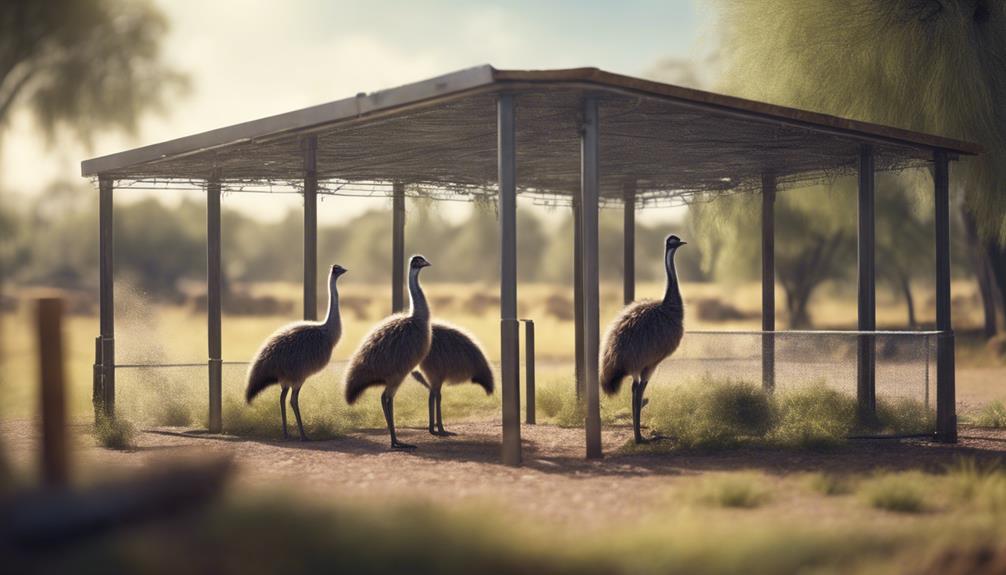
Imagine taking a step back in time as you embark on the journey of creating a safe haven for your emus.
The process of constructing an emu enclosure involves careful planning and attention to detail.
From the size considerations to the selection of materials, each step plays a crucial role in ensuring the well-being of your feathered friends.
As you delve into the intricacies of DIY emu care, you will discover the rewarding experience of building a space that meets both the physical and psychological needs of your emus.
Key Takeaways
- Allocate ample space, ventilation, and shelter for emus.
- Use durable, non-toxic materials for secure fencing.
- Design feeding stations and enrichment activities strategically.
- Maintain safety with regular inspections and predator protection.
Emu Enclosure Size Considerations
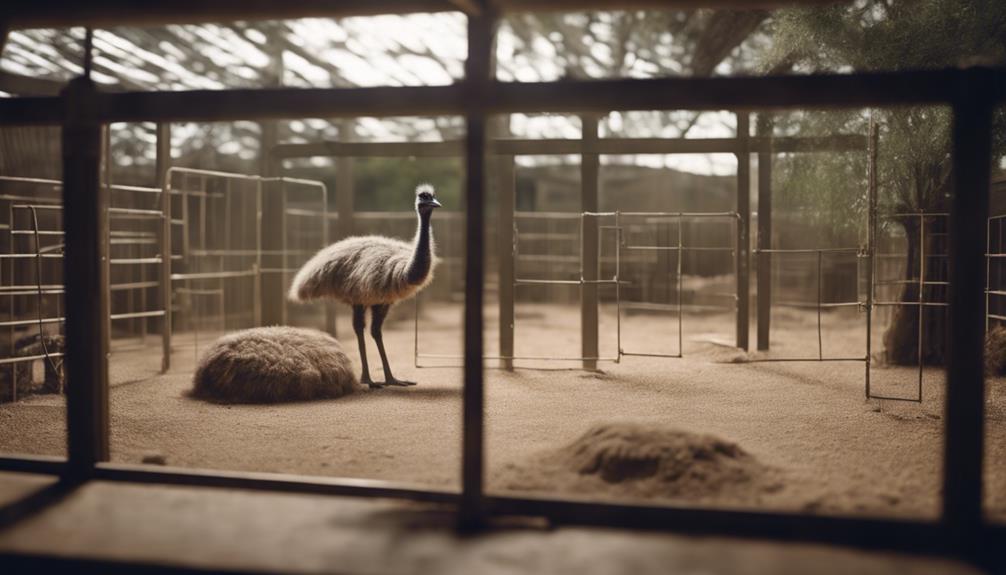
When planning the size of your emu enclosure, consider factors such as the number of emus and their need for space to move comfortably. Emus require ample space to roam as they're active birds that can run up to 30 miles per hour. For space requirements, allocate at least 1000 square feet per emu to allow them to exercise and exhibit natural behaviors. Emus also prefer dry, arid climates, so ensure the enclosure is well-ventilated and offers shelter from extreme weather conditions.
In terms of feeding habits, emus are omnivores and primarily eat plants, insects, and small animals. Incorporate feeding areas within the enclosure that are easily accessible and provide a varied diet to meet their nutritional needs. Furthermore, emus are social animals that thrive in small groups. Consider the social dynamics of your emus when determining the size of the enclosure to prevent overcrowding and potential conflicts among the birds.
Selecting the Right Location
To ensure optimal conditions for your emus, carefully consider the location where you'll build their enclosure. When selecting the right spot, take into account the following:
- Climate Considerations: Emus thrive in various climates, but it's essential to choose a location that suits the specific needs of these birds. Ensure the area you select provides adequate shelter from extreme heat or cold, and consider factors like humidity and rainfall patterns.
- Soil Quality: The type of soil in the chosen location can impact the health and well-being of your emus. Opt for well-draining soil to prevent waterlogging, which can lead to various health issues. Conduct soil tests to check for nutrient levels and pH balance.
- Landscaping Options, Location Advantages: Think about how you can leverage the natural landscape to benefit your emus. Consider options like incorporating natural vegetation for shade and foraging, or utilizing existing structures for shelter. Select a location that offers advantages like natural windbreaks or proximity to a water source for convenience.
Designing the Layout

Considering the optimal location for your emu enclosure, it's essential to now focus on designing the layout to ensure the comfort and well-being of your emus. When planning the layout, think about incorporating landscaping options to create a natural and stimulating environment for your emus. You may want to include areas with different vegetation types to mimic their natural habitat and provide shade and shelter.
For layout modifications, consider creating distinct zones within the enclosure. Designating a play area with soft ground cover will encourage exercise and mental stimulation for your emus. Additionally, ensure there are ample nesting spaces scattered throughout the enclosure for your emus to rest and lay eggs comfortably.
Choosing Suitable Materials
To ensure the longevity and safety of your emu enclosure, carefully select materials that are durable, weather-resistant, and non-toxic for your feathered friends. When choosing materials, keep in mind factors such as material durability, cost-effectiveness, weather resistance, and maintenance requirements.
Here are some key points to consider:
- Material Durability: Opt for sturdy materials like pressure-treated wood, galvanized steel, or PVC that can withstand the wear and tear of outdoor elements and the curious nature of emus.
- Cost Effectiveness: Balance the initial cost of materials with their long-term durability to choose options that provide the best value for your investment.
- Weather Resistance: Select materials that are designed to withstand varying weather conditions, ensuring your emu enclosure remains secure and intact over time.
Constructing the Fencing

When constructing the fencing for your emu enclosure, prioritize sturdy materials like pressure-treated wood, galvanized steel, or PVC to ensure durability and security for your feathered companions. Begin by leveling the ground to provide a stable foundation for the fence. Proper post spacing is crucial; aim for around 8 to 12 feet apart to maintain structural integrity. When setting up the gate, place it strategically to allow easy access for maintenance and prevent potential escape attempts by the emus. Ensure the wire is tightly tensioned to prevent sagging and maintain the fence's strength.
Galvanized steel wire mesh is an excellent choice for emu enclosures due to its durability and resistance to corrosion. When installing the fencing, securely attach it to the posts using appropriate fasteners to prevent gaps that the emus could exploit. Regularly inspect the fence for any signs of wear or damage, repairing promptly to uphold its effectiveness in containing your emus safely within their enclosure.
Adding Shelter Elements
For optimal shelter in your emu enclosure, incorporate a sturdy, weather-resistant structure that provides protection from the elements. To ensure your emus are well-protected and comfortable, consider the following:
- Weather Protection: Choose materials that can withstand various weather conditions, such as rain, wind, and sun exposure. Emus require a shelter that keeps them dry and shaded during extreme heat.
- Insulation Options: To regulate temperature within the shelter, insulation is crucial. This helps keep the enclosure warm in colder months and cool during hot weather, providing a stable environment for your emus.
- Camouflage Design: Opt for a design that blends well with the surroundings to provide natural camouflage for your emus. This helps them feel secure and hidden from potential threats.
When designing the shelter, also keep in mind predator prevention strategies to ensure the safety and well-being of your emus. By incorporating these elements, you can create a secure and comfortable shelter for your emus.
Providing Water Sources
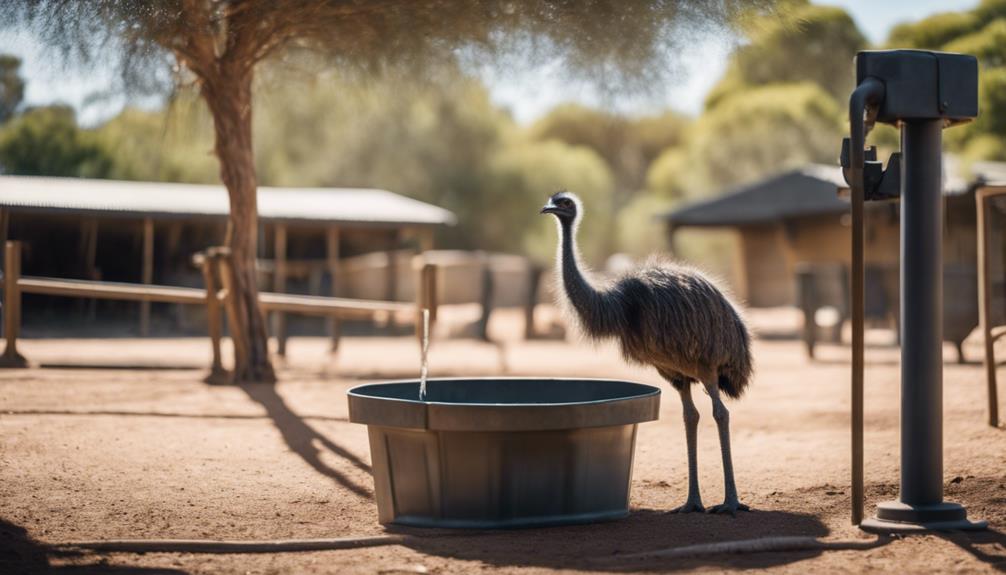
Ensure sufficient water sources are strategically placed within the emu enclosure to meet the hydration needs of your emus throughout the day. Emus require access to clean, fresh water at all times. Consider installing multiple water stations to prevent overcrowding and ensure all emus have equal opportunity to drink. Emus are known to splash around in water, so regular checks and refills are essential.
Establishing a watering schedule can help in maintaining optimal hydration levels for your emus. Emus may drink more during hot weather or after consuming dry feed. Monitor water consumption patterns to adjust the watering schedule accordingly.
Maintaining water quality is crucial for the health of your emus. Clean the water containers regularly to prevent the growth of harmful bacteria. Additionally, ensure that the water is free from contaminants and easily accessible to the emus.
Temperature regulation of the water is also important. During extreme weather conditions, check that the water isn't too hot or too cold for the emus. Providing shaded areas near the water stations can help keep the water at a moderate temperature. Regularly monitor the water sources to ensure they're in good condition and functioning properly.
Implementing Feeding Stations
Implementing feeding stations involves strategically planning designated areas within the emu enclosure where emus can access their food in a controlled and organized manner. Emus have specific feeding behavior and nutritional needs that must be met to ensure their health and well-being.
When setting up DIY feeding stations, consider the following:
- Location: Choose spots in the enclosure that are easily accessible to the emus but also protected from the elements to prevent food spoilage.
- Food Storage: Invest in containers that can securely hold the emus' feed, keeping it fresh and free from pests.
- Station Design: Design feeding stations that are sturdy and spacious enough to accommodate all emus in the enclosure comfortably.
Incorporating Enrichment Activities
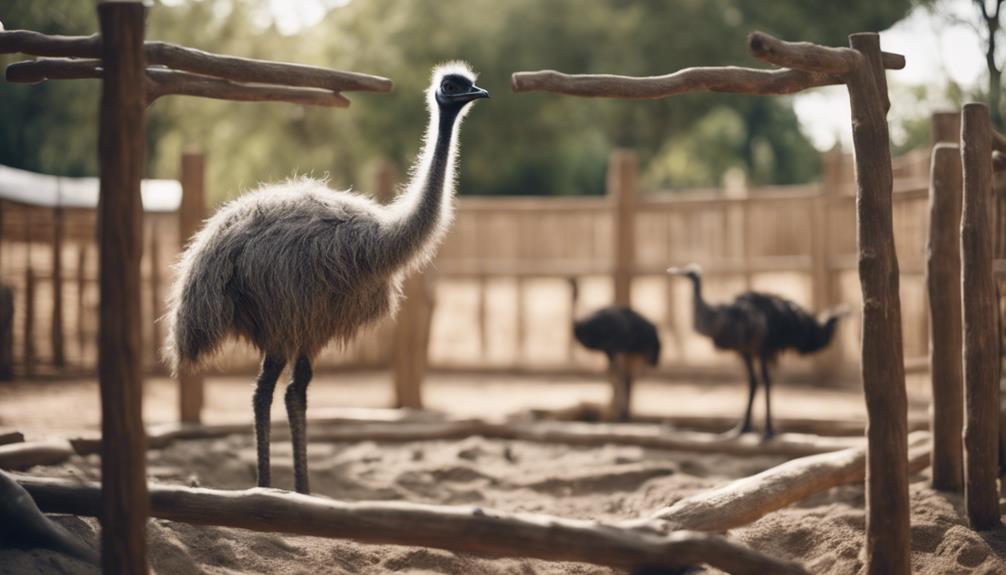
Integrating engaging enrichment activities into the emu enclosure enhances their mental stimulation and physical well-being. Enrichment activities are crucial for keeping your emus healthy and happy. By incorporating interactive toys and natural elements into their environment, you can provide them with opportunities for mental and physical exercise.
Here are some DIY ideas for enrichment activities you can include in your emu enclosure:
| Enrichment Activities | Description |
|---|---|
| Foraging Stations | Hide treats for them to find |
| Puzzle Feeders | Stimulate their problem-solving skills |
| Hanging Vegetables | Encourage pecking and reaching |
| Dust Bathing Area | Provide a space for natural grooming behavior |
Interactive toys like hanging balls or mirrors can keep your emus entertained and engaged. Additionally, adding natural elements such as logs, branches, or rocks can mimic their natural habitat and offer opportunities for exploration. Remember, a well-stimulated emu is a happy emu!
Ensuring Proper Ventilation
To maintain optimal health for your emus, it's essential to establish a ventilation system that promotes air circulation within their enclosure. Proper ventilation not only ensures fresh air but also helps regulate temperature and reduce humidity levels, all crucial for your emus' well-being.
Here are some key points to consider for ventilation maintenance and to safeguard your emus' health:
- Regular Inspections: Check ventilation openings for blockages, ensure fans are functioning correctly, and monitor airflow patterns within the enclosure.
- Enclosure Design: Consider the positioning of vents and fans to create cross-ventilation, allowing for a constant flow of fresh air throughout the space.
- Humidity Control: Install vents near water sources or damp areas to prevent moisture buildup, which can lead to respiratory issues in emus.
Installing Lighting Fixtures
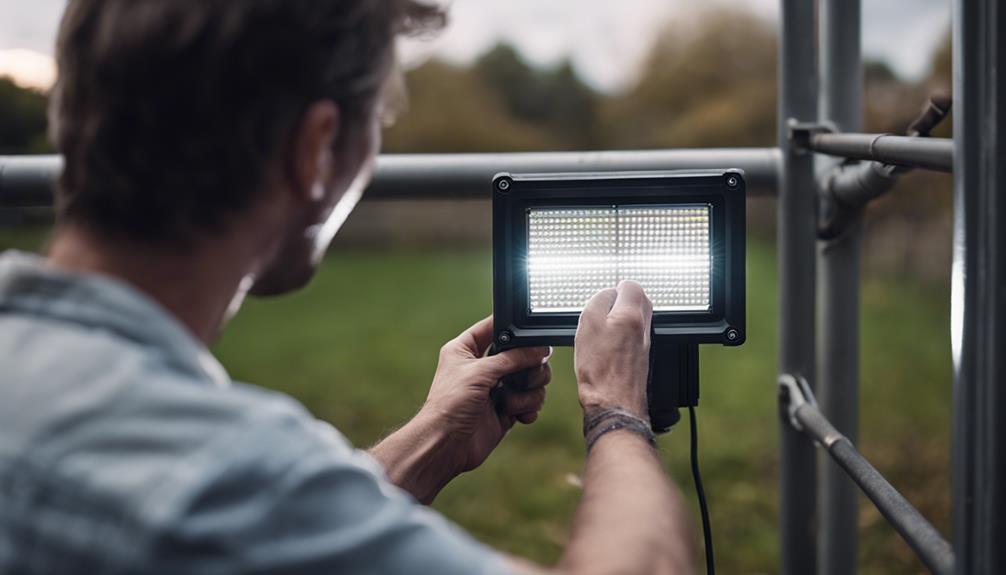
When setting up the lighting fixtures in your emu enclosure, prioritize positioning to ensure adequate illumination and create a suitable environment for your emus. Opt for energy-efficient bulbs to reduce electricity costs and minimize heat emission.
LED bulbs are a great choice as they're long-lasting and emit less heat, which is crucial for your emus' comfort. When installing the fixtures, make sure they're securely mounted and out of reach of curious emus to prevent any accidents.
Additionally, consider incorporating dimmer switches to adjust the lighting levels according to the time of day or your emus' behavior. This feature can help create a more natural lighting cycle, promoting better sleep patterns and overall well-being for your emus.
Remember to follow safety precautions when working with electrical components and always consult a professional if you're unsure about any aspect of the installation process. Prioritizing proper placement and using dimmer switches will contribute to a well-lit and harmonious environment for your emus.
Emu Safety and Security Measures
For enhanced safety and security within your emu enclosure, it's essential to implement robust measures to protect your emus and ensure a secure environment. To achieve this, consider the following:
- Predator Protection: Emus are vulnerable to predators such as foxes and dogs. Install fencing that's at least 6 feet high and buried into the ground to prevent digging. Additionally, consider using motion-activated lights or alarms to deter nocturnal predators.
- Escape Prevention: Emus are curious and agile birds that can escape through small openings or weak spots in fencing. Regularly inspect the enclosure for any damages or potential escape routes. Implement double gates or locks to prevent accidental openings.
- Behavior Observation, Health Monitoring: Spend time observing your emus daily to understand their normal behavior patterns. This will help you notice any signs of distress or illness early on. Regular health check-ups by a veterinarian are crucial to ensure your emus remain healthy and happy within their enclosure.
Frequently Asked Questions
Can Emus Be Housed With Other Types of Animals in the Same Enclosure?
Emus may not be suitable for inter-species housing due to their territorial and aggressive behavior. It's essential to prioritize their comfort and safety by providing a dedicated enclosure that meets their specific needs.
How Often Should the Enclosure Be Cleaned and Maintained?
To keep your emu enclosure clean and safe, it should be cleaned daily to prevent health issues. The frequency may increase based on size and how many emus are housed. Regular maintenance ensures a happy environment for these curious birds.
Are There Any Specific Regulations or Permits Required for Keeping Emus on a Private Property?
Before bringing emus to your property, it's essential to check permit requirements and zoning regulations. Some areas may have specific rules for keeping these birds. Ensure compliance to enjoy your emus legally and responsibly.
What Are Some Common Health Issues That Emus May Face, and How Can They Be Prevented or Treated?
To ensure your emu's well-being, you must be vigilant about preventative care. Regular check-ups and a balanced diet are crucial. If health issues arise, swift action is key. Consult a vet for treatment options to keep your emu healthy.
How Do You Handle Aggressive or Territorial Behavior in Emus Within the Enclosure?
When handling aggression and territory management in emus, it's crucial to establish yourself as the dominant figure. Implement clear boundaries, consistent routines, and positive reinforcement. Redirect aggressive behavior with distractions and never engage in physical confrontation.
Conclusion
As you put the finishing touches on your DIY emu enclosure, remember that creating a safe and stimulating environment for your feathered friends is essential.
Like a skilled architect crafting a masterpiece, every detail from the size of the enclosure to the materials used must be carefully considered.
With proper planning and execution, your emus will thrive in their new home, basking in the comfort and security you have provided for them.
Happy building!




